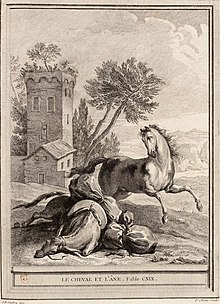The horse and the donkey
The horse and the donkey is an animal fable that deals with arrogance, failure to help and mutual concern for one another using the example of a donkey and a horse.
The fable appears for the first time in Aesop under the title “The laden donkey and the horse”, its morality alludes to the nobility and the middle class: “If high and low give each other help, the good of both is promoted.” Patterns of this Aesopian fable, however, direct morality to the general public.
“Once carried on his narrow back
a donkey a heavy burden,
capable of holding him dead.
A single horse walked beside him.
You have
nothing on your back, said the afflicted animal;
Help, dear horse, help, I beg you, help me!
What help! says the rough horse;
You are the right guest, you are a little lazy!
Wear it! -
I am dying, dear horse -
the burden is crushing me, save me!
Half would be a game for you!
I can not! said the horse.
In short, under the heavy sack
the donkey succumbed. Bag and pack
one threw the rough black horse;
the donkey's skin is still on top. "
Johann Wilhelm Ludwig Gleim emphasizes the character traits of his animal protagonists (the desperate donkey pleads in a caressing manner, while the unwilling horse scolds him with contempt). Jean de La Fontaine warned in his fable (French: “Le Cheval et l'Âne”) in a preceding teaching: “One is always helpful to the other in the world; your neighbor dies and his burden will surely fall on your shoulders. "
It is different, however, in the fable by Magnus Gottfried Lichtwer ; there donkey and horse talk at a manger, whereby the well-fed, carefree horse shows no understanding for the emaciated, battered donkey. The Lichtwersche morality at the end of the fable: “Then said the gray gentleman: Your stomach is full and full, and your wisdom comes from a full stomach. He preaches well and speaks of denial, who has no worries himself. "
Individual evidence
- ^ Johann Heinrich Ernesti : New theoretical-practical handbook of fine speech arts: for the upper classes of the scholarly schools. Poetry . Fleischmann, 1828, p. 6–7 ( google.de [accessed February 15, 2020]).
- ↑ " https://books.google.de/books?id=8QwaCAAAQBAJ&printsec=frontcover&dq=pferd+und+esel+gleim&hl=de&sa=X&ved=0ahUKEwiFmveEt9HnAhVLTsAKHVz1DOQQuwUIWTAF#v=onepage&q=pferd%20esel&f=true " p.180
- ^ Theodor Heinsius : New language and speech school of the Germans for school and self-instruction: Theoretical-practical textbook of reading and lecture art for school and self-instruction . E. Fleischer, 1833, p. 99 ( google.de [accessed February 15, 2020]).
- ^ Ernst Dohm (translator): Lafontaine's fables. P. 290 , accessed February 15, 2020 .
- ↑ Magnus Gottfried Lichtwer : POETICAL WRITINGS BY MG LICHTWER, KÖNIGL. PRUSSIAN COURT AND GOVERNMENT COUNCIL IN THE PRINCIPALITY HALBERSTADT .: I. THEIL . 1793, p. 169–170 ( google.de [accessed February 15, 2020]).
